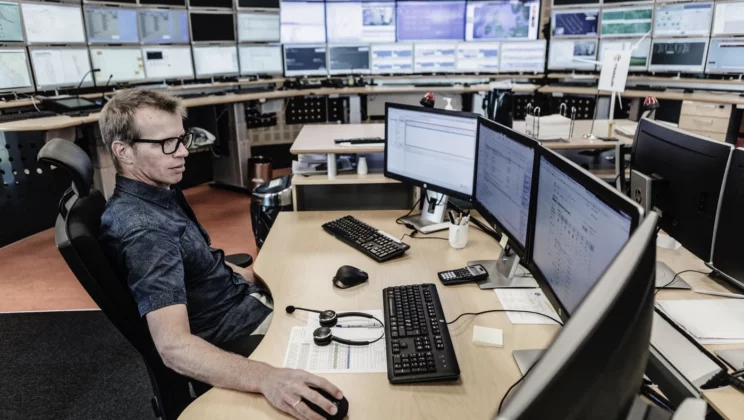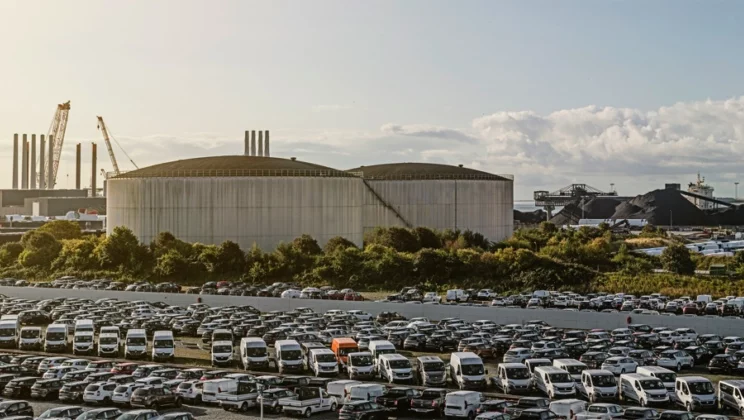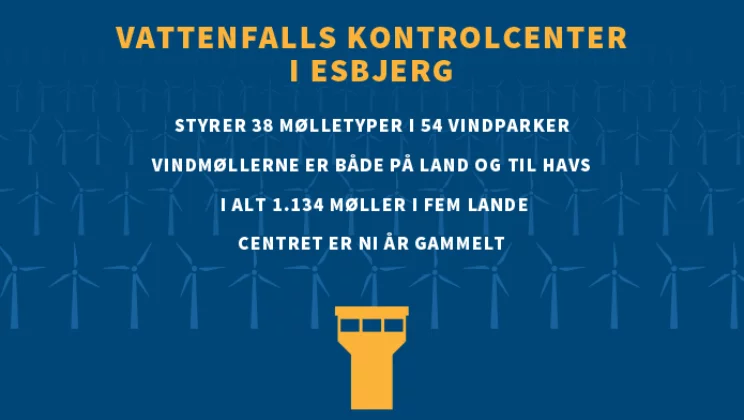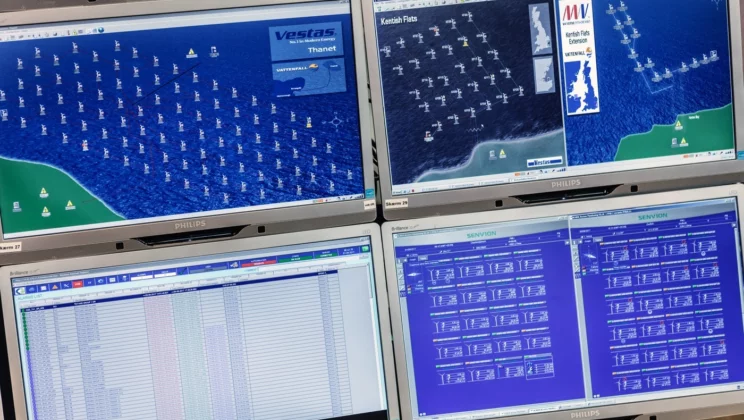At the surveillance centre in Esbjerg overlooking the Port of Esbjerg, Vattenfall monitors 1,134 wind turbines in five countries. Within just four years, the company expects to have doubled the 2.2 GW capacity it is currently monitoring. The surveillance centre is one of a kind.
A fish lazily swims around its aquarium, while a radio plays in the background. Considering this building in Esbjerg is where 1,134 wind turbines – measuring up to 200 metres and located in the Netherlands, Germany, the UK, Denmark and Sweden – are monitored and controlled, the room is quiet. Very quiet.
The surveillance centre of Swedish energy company Vattenfall monitors 38 types of turbine from 10 different manufacturers, such as Vestas and Enercon, with many of the turbines being live-streamed from sites around northern Europe. And you can see the blades are turning fast.
Sitting in an office chair, Jan Jørgensen, Head of Surveillance at the surveillance centre, calmly looks up at the sound of an electronic alarm. The two-man surveillance team on duty knows what to do, and the room falls silent again after a few seconds.
The alarm goes off 70,000 times a year, or roughly every seven minutes. Something is wrong with a turbine and a response is required. Often, it is simply a matter of rebooting some software. But sometimes technicians have to be dispatched by car, boat or helicopter to carry out repairs. Every minute a turbine is not running costs money. If a 10 MW turbine stops for one hour, 10,000 kWH are lost, or the equivalent of the annual consumption of 2.5 households. So every minute counts.
In May, 99.6% of the alarms were responded to within five minutes, as the surveillance centre is manned 24/7 all year round.
The surveillance centre reflects Vattenfall’s focus on wind power. And business is good.
“We have seen steady growth since we opened the centre, and we expect this trend to continue. Our target is to double the 2.2 GW we are currently monitoring within just four years,” says Arne Rahbek, Senior Policy & Communication Advisor at Vattenfall, who has joined us in front of the screens for the occasion.

In the surveillance centre, Vattenfall monitors 1,134 wind turbines in five countries.
Wind power is a core product
The centre is the only one of its kind in the world and Vattenfall has built it for a good reason. Wind power will be one of Vattenfall’s core products in the years ahead, with offshore operations in particular expected to grow strongly. According to Mr Rahbek, two-thirds of Vattenfall’s new investments are in wind power.
“Vattenfall is phasing out fossil fuels. We are divesting them, and they are no longer part of our DNA,” he says. So the centre is also a future investment in an area which Vattenfall expects to grow. And also in Esbjerg.
Buzzing with energy
Vattenfall has an ideal location in Esbjerg surrounded by energy production. From the canteen, you can see mountains of coal that belong to the neighbouring power plant, and on a clear day you can grab a pair of binoculars and see the wind turbines of the Horns Rev 1 wind farm 30 km further out on the horizon. Not to mention the hundreds of turbine components lined up on the waterfront that can be seen from Vattenfall’s surveillance centre. And then there are the oil and gas rigs further down the quayside waiting to suck up energy from under ground.
The Port of Esbjerg is buzzing with energy – from coal, oil and, more recently, from wind turbines located far out to sea.

From Vattenfall's surveillance centre one has the full view of the Port of Esbjerg.
Fluctuating electricity prices
In the bunker, as the centre is called, besides monitoring the turbines via web cams, they can also track electricity prices, which fluctuate considerably. Part of the surveillance technicians’ job is to shut down turbines when there is overproduction relative to the market, as electricity cannot be stored. For example, as factories are closed on Christmas Eve, power consumption is very low and production is adjusted accordingly.
“We can adjust the blades or stop them completely, and we have various other manoeuvres to regulate how much electricity we produce,” says Jan Jørgensen, who is in charge of the bunker.
He can look at the screens where more than a thousand different error codes for the wind turbines may appear. The surveillance technicians do not fix the problems themselves, but they contact the people who can. The temperature in the turbines may be too high, or there may be software glitches or mechanical problems, or whatever. In that case, the surveillance team contacts technicians in Sweden, Germany, the UK or the Netherlands. Or in Esbjerg, where a boat is just on its way out to a turbine, while the control system, Wind Manager, is showing that 153,792 kW is being produced right now by turbines located across Europe.
Over the years, helicopters have been called in 25,000 times to fly a technician to an offshore wind turbine because the waves were too high for the boats, and there has never been an accident.
135 of the wind turbines are out of service during our short visit to the control centre, most of them because of service checks, which are usually made during the summer. And of course production has to be adjusted to demand.

Esbjerg is a serious player
Although Vestas and other companies have their own surveillance rooms, the surveillance centre in Esbjerg is the only one of its kind in the world. And Denmark is a global centre for wind power; in 2016, 38% of Denmark’s electricity consumption came from wind power.
“The Port of Esbjerg is a serious and important player in Denmark, and it is no coincidence that our surveillance centre is located here,” says Mr Rahbek, who stresses that he expects the port to continue with the positive trend it has been experiencing for the past many years. Wind turbines in the 12-15 MW range, perhaps as tall as 300 metres, may soon become a reality. The world record today is 9MW, but that is about to be challenged.
A unique infrastructure will be required to handle the turbine components at the port as well as sufficient storage capacity.
When loading the turbines, the installation vessels may need to lower their support legs down to the sea bed, so a foundation may have to be laid in the harbour, according to Mr Rahbek. Also, waiting time for vessels should be avoided, as that is very costly in the offshore business.
Green energy
According to Mr Rahbek, green energy is the energy form of the future.
“Green consciousness is good for everyone. It may be a cliché, but that makes it no less true. This wasn’t the case five years ago, but it is now. We want green energy, and in my opinion, green energy in Denmark is also one of the reasons why Apple has placed a data centre in Viborg, Facebook in Odense and so on,” says Mr Rahbek.
The wind farms Horns Rev 3 and Kriegers Flak are groundbreaking projects for Vattenfall and are extremely important for the entire offshore industry because of their magnitude. Also, they have helped ensure the kWh price of offshore wind power can now approach the level of onshore wind turbines.
Mr Rahbek is therefore very positive about the situation.
“We believe this is just the beginning. And with this surveillance centre in Esbjerg, we have taken an important step in keeping up with developments,” he remarks.
Denmark’s current energy agreement expires in 2020. Mr Rahbek expects negotiations on a new agreement that will favour wind power to commence soon.
“Declarations of intent are fine, but we need to be certain before the entire supply chain, including development and production, is set in motion onshore and offshore. We contribute to making it attractive for energy-consuming companies to set up business in the Nordic region and in Denmark. And we hope for political support as well,” says Mr Rahbek.
The fish is still swimming lazily around its aquarium at the surveillance centre when the next alarm sounds. And it can calmly do so, for it only takes a moment before the new alarm has been managed.
Green energy
According to Mr Rahbek, green energy is the energy form of the future.
“Green consciousness is good for everyone. It may be a cliché, but that makes it no less true. This wasn’t the case five years ago, but it is now. We want green energy, and in my opinion, green energy in Denmark is also one of the reasons why Apple has placed a data centre in Viborg, Facebook in Odense and so on,” says Mr Rahbek.
The wind farms Horns Rev 3 and Kriegers Flak are groundbreaking projects for Vattenfall and are extremely important for the entire offshore industry because of their magnitude. Also, they have helped ensure the kWh price of offshore wind power can now approach the level of onshore wind turbines.
Mr Rahbek is therefore very positive about the situation.
“We believe this is just the beginning. And with this surveillance centre in Esbjerg, we have taken an important step in keeping up with developments,” he remarks.
Denmark’s current energy agreement expires in 2020. Mr Rahbek expects negotiations on a new agreement that will favour wind power to commence soon.
“Declarations of intent are fine, but we need to be certain before the entire supply chain, including development and production, is set in motion onshore and offshore. We contribute to making it attractive for energy-consuming companies to set up business in the Nordic region and in Denmark. And we hope for political support as well,” says Mr Rahbek.
The fish is still swimming lazily around its aquarium at the surveillance centre when the next alarm sounds. And it can calmly do so, for it only takes a moment before the new alarm has been managed.

The control system, Wind Manager, help the surveillance team to make sure that everything is as it should be at the turbines.
Go to overview

